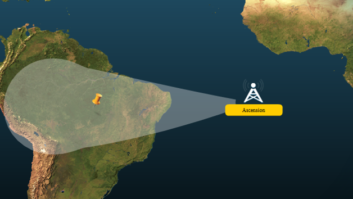As recently as 25 years ago, shortwave radio was a preferred source of breaking international news in North America.
Most hours of the day, the BBC World Service boomed in, especially at night on 6175 kHz. There was also Radio Moscow — once the mouthpiece of old-style Soviet propaganda — the Voice of America, Radio Netherlands, Deutsche Welle from West Germany and Radio Berlin International from East Germany.
If you wanted to know what was happening in Cuba, Tel Aviv or what was then called Bombay, you could tune to Radio Havana, Kol Yisrael or All India Radio directly.
120 million people
At the time, the BBC estimated global shortwave listenership to be in excess of 120 million people weekly. Granted, most of that audience was outside of North America. But back when there was no awareness of the Internet and no international satellite TV, shortwave was where many news-hungry North Americans went first.
Scan across the shortwave bands and you’ll find that much has changed. In North America and Europe, many of the major broadcasters have disappeared or minimized their presence. In fact, the BBC World Service no longer beams programming via shortwave to the Americas or most of Europe.
“There has been a massive decline in shortwave listenership, especially in Europe and North America,” said Andy Sennitt. He is one of the world’s most respected experts on shortwave radio and the editor in charge of the Radio Netherlands Worldwide “Media Network” Web site.
“Media Network” began in 1981 as a weekly shortwave program; in 2000 that show ended in favor of its current online presence.
“Other regions vary from country to country,” said Sennitt. “Shortwave is still significant in much of Africa, South Asia and parts of Latin America.”
What changed?
It is easy to blame the Internet and international satellite television for the decline in shortwave radio listenership. But shortwave was in trouble before these new media took hold, said Larry Magne.
He is publisher of Passport to World Band Radio, the annual shortwave radio tuning guide that thrived for 25 years but suspended publication in 2009.
“We reached an apex in shortwave radio listenership in 1989, when the Cold War ended,” said Magne. “Shortwave audiences have been in decline since then.”
“AM broadcasting is expensive, and, since the end of the Cold War, many Western governments don’t see the need to spend large amounts on transmitting their output on shortwave,” said Sennitt. “As a result, some have closed down their shortwave services altogether. Others have created satellite services and/or partner with local stations in key targets, and most now stream their programming on the Internet.”
Magne said he believes it was the BBC World Service that speeded shortwave’s decline in North America. In 2001, then-BBC World Service Director Mark Byford decided that local AM/FM rebroadcasting, satellite radio and the emerging Internet made it possible to stop shortwave broadcasts to North America. (Byford is now BBC deputy director general.)
The move, hotly contested by avid shortwave listeners, had a domino effect.
“After the BBC ended its North American broadcasts, other broadcasters followed suit,” said Magne. “The result is that North Americans don’t get much in the way of shortwave programming these days. Spectrum that once carried international news and programming is now host to U.S. fundamentalist religious stations.”
Kim Andrew Elliott, a former VOA contributor who reports on international broadcasting at his Web site, www.kimandrewelliott.com, adds that BBC World Service was attracting more listeners via U.S. public radio stations than via shortwave when the shutdown occurred. “Those FM listeners are, however, not exposed to as wide a variety of BBC programming than was available on shortwave,” he said.
In Elliott’s day job as audience research analyst for the International Broadcasting Bureau, he has seen audiences migrate to FM overseas as well.
“For example, a 2009 survey shows that of Cambodians who listen to VOA Khmer, 63 percent do so via FM affiliates in the country, 31 percent via the medium-wave relay from Thailand, and only 6 percent via shortwave,” Elliott said.
He also noted that in a 2003 survey in India, 7 percent of respondents said they listened to shortwave radio yesterday, and 7 percent to FM. By 2008, that changed to 18 percent for FM and 2 percent for shortwave.
(Under current broadcasting rules, private FM stations in India cannot carry news programming, which means VOA, BBC, RFI and other international broadcasters do not have local FM partners, as they do in other nations.)
International radio now
Today, the BBC and other international radio broadcasters are indeed available on the Web and satellite radio. But most of the attention that went to radio services is now directed toward Web sites and international television stations.
Meanwhile, the attempt to save money by distributing international programs to domestic broadcasters is backfiring, said German shortwave expert Kai Ludwig.
“Often they cease because the programming from the foreign broadcaster is just no longer considered as appealing,” said Ludwig. “For example, Radio Free Europe/Radio Liberty lost its full-coverage FM rebroadcasts in Ukraine when their partner station reformatted to adult contemporary music.”
Even when domestic stations do carry international radio programs, they cannot match the coverage and reach of shortwave radio, he added. “Online streaming is of course a valuable addition, but here the competition is just overwhelming.”
Meanwhile, the religious stations that have moved onto shortwave do not appear to be making money from it.
“Are people listening? The answer can be found in such developments like Christian Vision withdrawing its programming from transmitters in Germany and Australia; HCJB not replacing the shortwave plant it recently closed in Ecuador, and Evangeliums-Rundfunk, the German partner of Trans World Radio no longer using shortwave,” Ludwig said.
Digital shortwave
There had been hopes that digital shortwave receivers using the Digital Radio Mondiale standard, which do not suffer analog shortwave’s traditional audio problems, would be the savior of the medium.
Unfortunately, “DRM was a decade too late, and badly marketed,” said Sennitt. “It has its uses for specialist tasks — such as Radio New Zealand delivering its shortwave programs to Pacific partner stations — but as a mainstream shortwave broadcasting platform it’s as dead as a dodo. … The other problem, of course, is that the shortwave receiver companies didn’t keep their side of the bargain to develop affordable mass-produced DRM receivers.”
As well, “in many cases I’ve heard DRM stations using telephone-grade bitrates because it’s the only thing that would get through to the target,” said Elliott. “Higher bitrates, with better audio, often don’t get through.” Given these facts, Andy Sennitt said he expects “shortwave broadcasting to Europe and North America will be almost totally phased out, but there will still be shortwave services to Africa and parts of Asia.” These services will continue until those regions develop radio, TV and Internet infrastructures akin to the developed world.
Irreplaceable advantage
For all its transmission expense and audio problems, analog shortwave radio has one clear advantage over the Internet and domestic radio/TV: It cannot be easily blocked — even when states try to disrupt its signals using jamming transmitters.
Webcasts can be filtered or blocked through IP geolocation techniques that block access to sites based upon the IP address of the site or the user.
Access to local radio transmitters can be withdrawn by officials. For example, Radio Azadliq, the RFE/RL service for Azerbaijan, along with VOA and the BBC World Service, was forced off local FM and medium-wave frequencies at year-end 2008 after its often critical coverage of that year’s elections.
“The Internet, satellite signals and placement AM/FM can all be blocked by a determined officialdom,” said Magne. “Yet properly executed analog shortwave tends to get through when others fail. Because of this, international broadcasters have the potential of saying pretty much what they please, when they please, and to whom they please; they don’t have to self-censor their messages to appease gatekeepers.
“According to Lech Walesa, Václav Havel and other freedom leaders behind the former Iron Curtain, this ability to circumvent gatekeeping was the main reason communism was defeated in Eastern Europe,” he added.
Information is still being censored not just in North Korea, Iran and Saudi Arabia, but Tunisia, Vietnam, Cuba and China, among other nations. Shortwave advocates argue that their favored platform remains relevant at a time when outside information is as important as it was in the Cold War.












